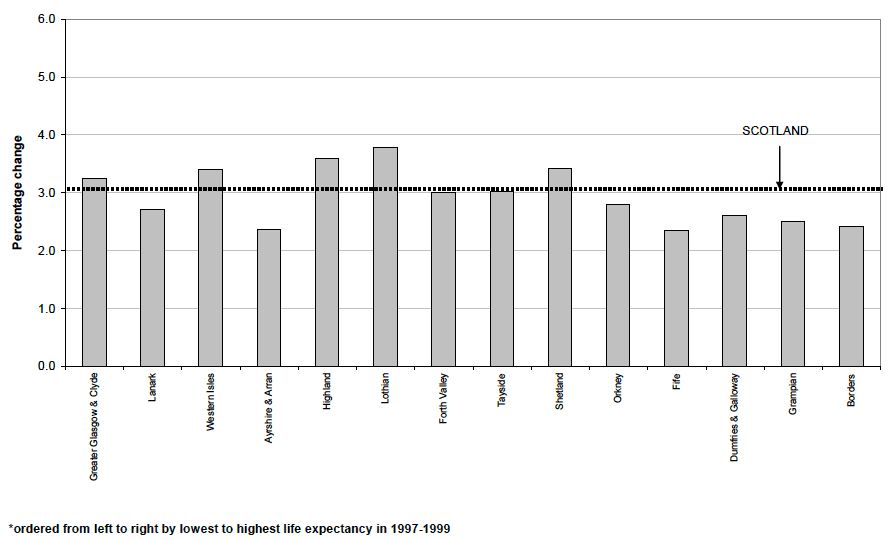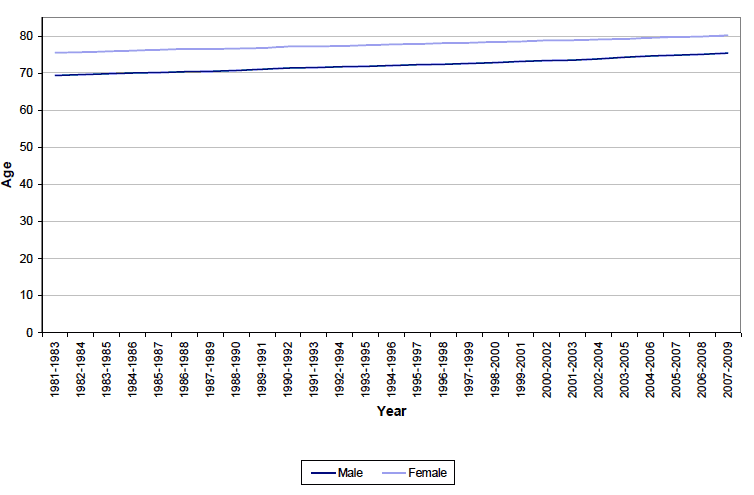
3.1 The Scottish Picture: Changes over time
3.1.1 Life expectancy at birth provides a useful summary measure of mortality rates actually experienced over a given period. It also provides an objective means of comparing trends in mortality, over time, between areas of a country and with other countries. This is of particular use in monitoring and investigating health inequality issues across Scotland and in setting public health targets. One of the Government’s current targets is to increase healthy life expectancy at birth in the most deprived areas. Healthy life expectancy is derived by combining estimates of life expectancy with data on self-assessed health (from surveys). Other related Government targets are to reduce mortality from Coronary Heart Disease (CHD), cancer and strokes among the under-75s in deprived areas. Although CHD is the only National Indicator of the three, combined they will have an impact on mortality and therefore also have an impact on estimates of period life expectancy figures.
3.1.2 Figure 1 shows that the expectation of life at birth in Scotland has improved over the last 26 years. It has increased from 69.3 years for males born in the period 1981-1983, to 75.4 years for those born in 2007-2009, an increase of 6.1 years. For females, life expectancy has increased from 75.5 years for those born in the period 1981-1983, to 80.1 years for those born in 2007-2009, an increase of 4.6 years.
Figure 1 Life expectancy at birth, Scotland, 1981-1983 to 2007-2009

3.1.3 Figure 1 also shows that the gap between life expectancy at birth for men and women is closing, having dropped from 6.2 years in 1981-1983 to 4.7 years in 2007-2009.
3.1.4 Life expectancy figures for Scotland are also produced by the Office for National Statistics (ONS) using complete life tables based on single years of age, in addition to the abridged life tables based on grouped years. For more details see Section 4.1.
3.2 UK and International comparisons
3.2.1 Eurostat (see Section 4.2.5 for more information) publishes data to allow comparison of life expectancy figures between European countries. The latest year for which data is available for all countries is 2007 and the following comparisons are based on data from this year for all countries including the UK and Scotland.
3.2.2 Figure 2a and Figure 2b show that Scottish men and women have among the lowest life expectancy at birth in comparison with EU272 states. For Scottish men, expectation of life is 1.0 years lower than the EU27 average (76.1 years) and 2.3 years lower for Scottish women (82.2 years is the EU27 average). Swedish men, who have the highest life expectancy at birth in this category, can expect to live 4.0 years longer than Scottish men. Similarly, French women can expect to outlive Scottish women by 4.9 years.
3.2.3 Figure 2a and Figure 2b also show Scotland’s position relative to the EU153 states. The gap between life expectancy in Scotland and that of the EU15 is wider than between Scotland and the EU27 for men and women. Life expectancy in the EU15 is 2.6 years greater than in Scotland for men and 3.6 greater for women.
3.2.4 The average life expectancy at birth for the whole of the UK is 2.5 years higher for men and 1.8 years higher for women, as shown in Figure 2a and Figure 2b. For 2007, only in one Scottish Council area, East Dunbartonshire, did male life expectancy exceed the UK average (77.5 years). For women, only in East Dunbartonshire and East Renfrewshire did current life expectancy exceed the 2007 UK average (81.7 years).
3.2.5 The gap between Scottish life expectancies at birth and those of the UK, the EU15 and the EU27 is not narrowing. For men, the gap between Scottish and UK life expectancies (2.5 years), and between Scottish and EU15 life expectancies (2.6 years), is as high as at any point in the past 10 years and has widened since 1997 by 0.4 years (UK) and 0.4 years (EU15). Comparing Scottish and EU 27 male life expectancies since 2002 shows the gap remaining at 1.0 years, though the figure has dropped to 0.8 years on two occasions. The same comparisons between female life expectancy in Scotland and those in the UK, EU15 and EU27 (which are 1.8 years, 3.6 years and 2.3 years respectively) show that the UK figure has risen marginally from the previous year and the UK and the EU15 figures are now at their highest level in the last 10 years.
Figure 2a Life expectancy at birth, EU27 countries, 2007, Males
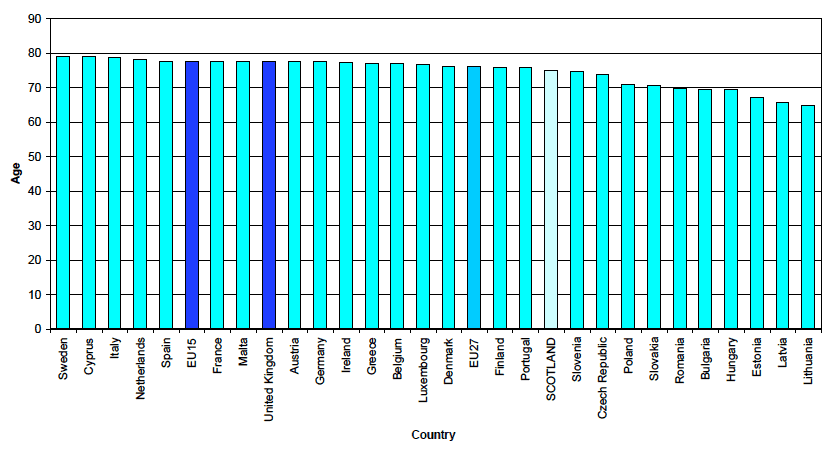
Source: EUROSTAT, ONS and GROS
Figure 2b Life expectancy at birth, EU27 countries, 2007, Females
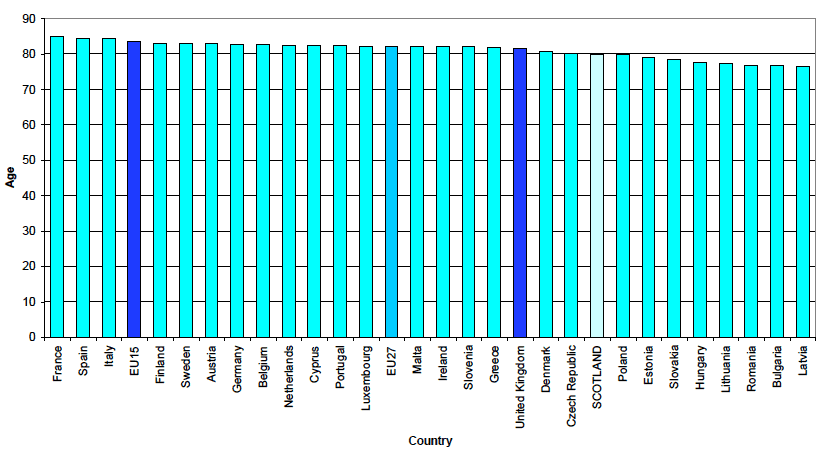
Source: EUROSTAT, ONS and GROS
3.3 Life expectancy at birth, 2007-2009, geographical variations
3.3.1 Table 1, Table 2 and Table 3 show life expectancy at birth in Scotland for 2007- 2009 for Council and NHS Board areas along with rankings for each area.
3.3.2 For men, the Council area with the lowest life expectancy was Glasgow City (71.1 years), and the Council area with the highest life expectancy was East Dunbartonshire (78.3 years), 7.2 years more than Glasgow City.
3.3.3 For women, East Dunbartonshire also had the highest life expectancy (83.1 years), 5.6 years more than Glasgow City, the area with the lowest figure (77.5 years).
3.3.4 Within NHS Board areas, the lowest life expectancy for men and women was in Greater Glasgow & Clyde (73.1 and 78.9 years respectively).The NHS Board area with the highest male life expectancy was Borders (77.1 years) and the highest female life expectancy was Western Isles (82.0 years).
3.4 Life expectancy at age 65, 2007-2009, geographical variations
3.4.1 Table 6 shows life expectancy at age 65 for Scotland and its administrative areas along with their rankings. This shows that, for Scotland, men aged 65 could expect to live a further 16.5 years and women a further 19.1 years if mortality rates remain the same as they were in the period 2007-2009.
3.4.2 For men and women, the Council area with the lowest life expectancy at age 65 was Glasgow City (13.9 years and 17.6 years respectively). The Council area with the highest life expectancy at age 65 for men and women was East Dunbartonshire (18.3 and 20.9 years respectively), 4.4 years for men and 3.3 years for women more than Glasgow City.
3.4.3 The NHS Board area with the lowest life expectancy at age 65 was Greater Glasgow & Clyde (15.2 years) for men and Lanarkshire for women (18.3 years). The NHS Board area with the highest life expectancy at age 65 for men and women was Shetland (18.0 years and 20.7 years respectively), which, for men, was 2.8 years more than Greater Glasgow & Clyde and, for women, was 2.4 years more than Lanarkshire.
3.5.1 Life expectancy at birth is an estimate which is subject to a margin of error. The accuracy of the results can be indicated by calculating a confidence interval which provides a range of values within which the true underlying life expectancy would lie (with 95% probability).
3.5.2 The 95% confidence intervals for life expectancy at birth and at age 65 are given in Table 7 and Table 8, and are illustrated in Figure 3, Figure 4, Figure 5 and Figure 6 for Council and NHS Board areas within Scotland.
3.5.3 There is no simple ‘rule of thumb’ for the size of confidence intervals, although it largely depends upon the size of the population: areas with small populations tend to have wider confidence intervals. It is also worth noting that life expectancy results in these areas can be affected by the random variation in the annual number of deaths. This means that the results vary from period to period. For example, in Table 1, Table 2 and Table 3, changes in rank may simply be due to random variation from year to year in the population and number of deaths (particularly in the smaller areas such as Orkney and Shetland) as opposed to a real change in the number of years one can expect to live. Rankings are only significantly different if the confidence intervals do not overlap e.g. in Figure 4, life expectancy at birth for men in Shetland is only significantly different from that of men in Greater Glasgow & Clyde; all other Health Boards have overlapping confidence intervals and therefore do not have significantly different life expectancies.
3.5.4 More information about the methods used to calculate the standard errors and confidence intervals used in this report can be found in the ONS methodology paper ‘Life expectancy at birth: methodological options for small populations’. See Section 4.2.4 for details of how to access this report.
Figure 3 Life expectancy at birth, 95% confidence intervals for Council areas, 2007-2009 (Males and Females)
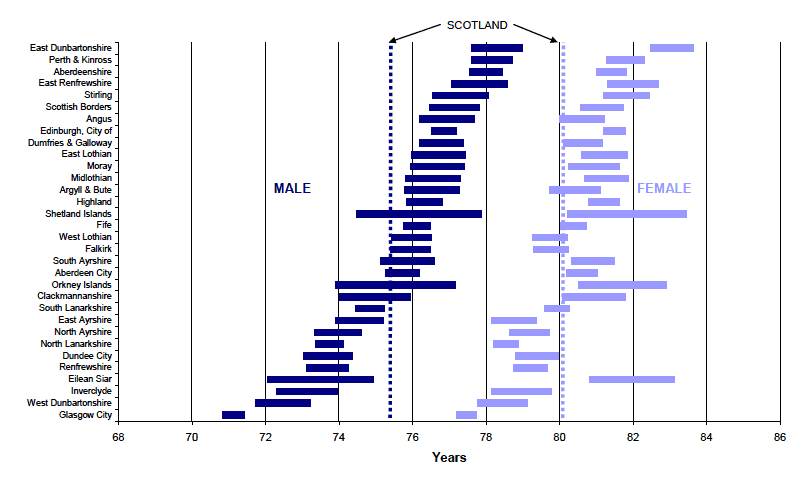
Figure 4 Life expectancy at birth, 95% confidence intervals for NHS Board areas, 2007-2009 (Males and Females)
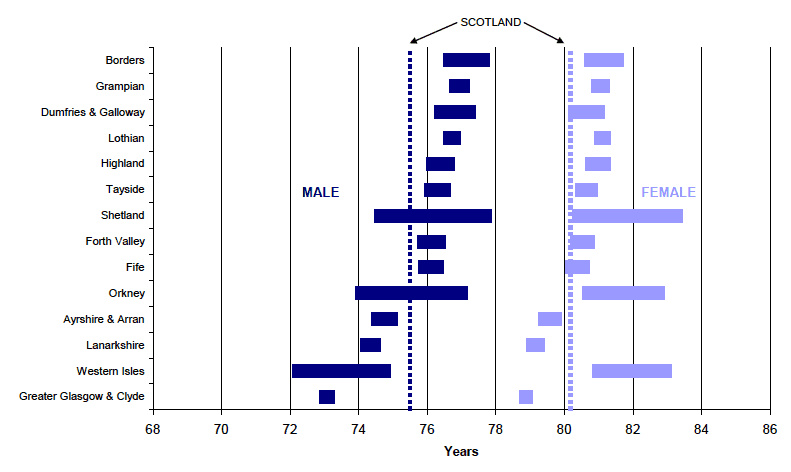
Figure 5 Life expectancy at age 65, 95% confidence intervals for Council areas, 2007-2009 (Males and Females)
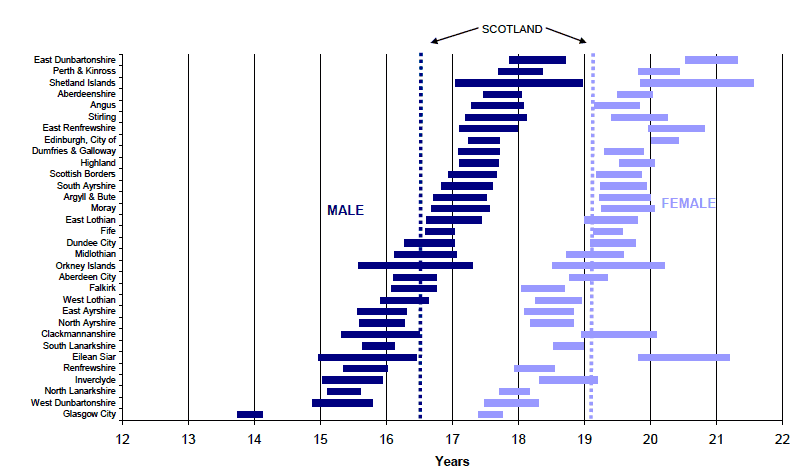
Figure 6 Life expectancy at age 65, 95% confidence intervals for NHS Board areas, 2007-2009 (Males and Females)
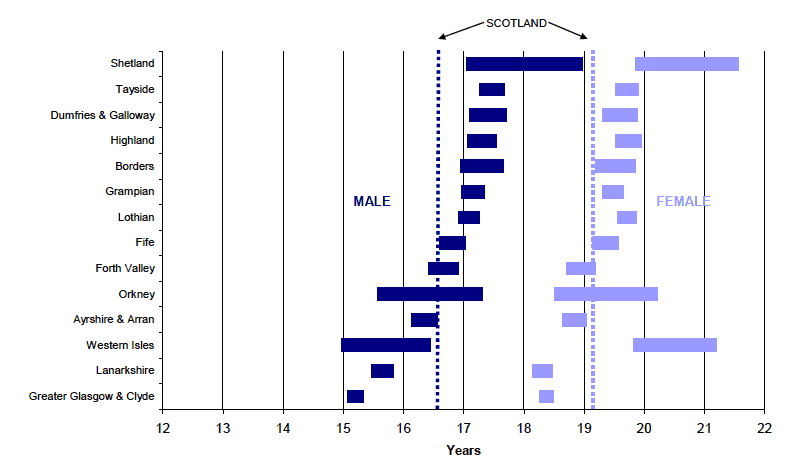
3.6 Life expectancy at birth, comparisons between 1997-1999 and 2007-2009
3.6.1 In the ten years since 1997-1999, life expectancy at birth in Scotland has increased by 2.7 years for men (from 72.7 years to 75.4 years), and 1.9 years for women (from 78.2 years to 80.1 years). Table 1, Table 2 and Table 3 show the highest and lowest ranking Council and NHS Board area for both periods. The tables also show that the gap in life expectancy between men and women is closing, from 5.5 years in 1997-1999 to 4.8 years in 2007-2009.
3.6.2 For men, the gap between the Council area with the highest life expectancy and the Council area with the lowest life expectancy has decreased by 0.6 years – from 7.8 years in 1997-1999 to 7.2 years in 2007-2009. For women, the gap has increased by 0.4 years – from 5.2 years in 1997-1999 to 5.6 years in 2007-2009. For NHS Board areas, the gap between highest and lowest life expectancy for men decreased by 0.5 years (from 4.6 years to 4.1 years) but increased by 0.1 years for women (from 3.0 years to 3.1 years).
3.6.3 The maps in Figure 7 and Figure 8 show the percentage change in life expectancy over the 10 year period for Council areas. For men, life expectancy increased the most in West Lothian – by 5.4 per cent (3.9 years), while East Renfrewshire had the smallest increase with 2.0 per cent (1.5 years). For women, life expectancy increased the most in East Dunbartonshire – by 4.5 per cent (3.6 years), with the lowest increase of 1.6 per cent shared between East Renfrewshire (1.3 years), Inverclyde (1.3 years) and Fife (1.2 years). No Council area showed a decrease in life expectancy for either men or women.
3.6.4 Figure 9a, Figure 9b and Figure 9c also show the percentage change in life expectancy within Council areas over the 10 year period and are ordered from left to right by the lowest to highest life expectancy in 1997-1999. There does not appear to be any obvious pattern to the change – the highest ranked areas from 1997-1999 have not continued to pull ahead over the period.
3.6.5 The maps in Figure 10 and Figure 11 show similar information for NHS Board areas. For men, Highland had the largest increase with 4.7 per cent (3.5 years) and Ayrshire & Arran the smallest with 2.5 per cent (1.8 years). For women, Lothian had the largest increase with 3.2 per cent (2.5 years) and Fife the smallest with 1.6 per cent (1.2 years). No NHS Board area showed a decrease in life expectancy for either men or women.
3.6.6 Figure 12a, Figure 12b and Figure 12c show the percentage change in life expectancy for NHS Board areas over the 10 year period and are ordered from left to right by the lowest to highest life expectancy in 1997-1999. As with the percentage increases in Council areas, there was no particular pattern to the changes and higher ranked areas in 1997-1999 did not consistently perform better than lower ranked areas over the period.
3.6.7 Over the 10 year period, the ranking of many Council and NHS Boards has changed (Table 1, Table 2 and Table 3). For men, West Lothian Council area has risen 8 places to 17th while South Ayrshire has fallen 8 places to 19th. East Dunbartonshire has replaced East Renfrewshire as the Council area ranked number 1 for male life expectancy. For women, Midlothian has risen 11 places to 10th, while Scottish Borders has fallen 9 places to 13th. East Dunbartonshire has replaced East Renfrewshire as the Council area ranked number 1 for female life expectancy.
3.6.8 Of the NHS Board areas, for men, Highland has risen 5 places to 5th and Fife has fallen 5 places to 9th. For women, Lothian has risen 5 places to 5th with Fife having fallen 5 places to 11th. For men, Borders remains the NHS Board area ranked number 1 for life expectancy and for women, Western Isles replaces Shetland as the NHS Board area ranked number 1 for life expectancy.
3.6.9 When confidence intervals for the results are taken into account, many of the changes in the rankings over time are not exact, especially for areas with relatively small populations such as Orkney and Shetland. Confidence intervals for 1997- 1999 are not presented here, but male and female figures are available from the ONS website through the following link:
http://www.ons.gov.uk/ons/publications/re-reference-tables.html?edition=tcm%3A77-198966
3.6.10 Over a shorter period, within the last 5 years (see Table 9 and Table 10), Council areas have shown a slight decrease in the gap between the highest and lowest life expectancies for men, down from 7.7 years to 7.2 years while for women the gap has grown from 4.4 years to 5.6 years. In NHS Board areas both male and female life expectancy widen and narrow from year to year but decrease over the 5 year period. For men it narrows from 5.3 years to 4.1 years and for women it widens from 3.0 years to 3.1 years.
Figure 7 Percentage change in life expectancy at birth between 1997-1999 and 2007-2009, Council areas, Males
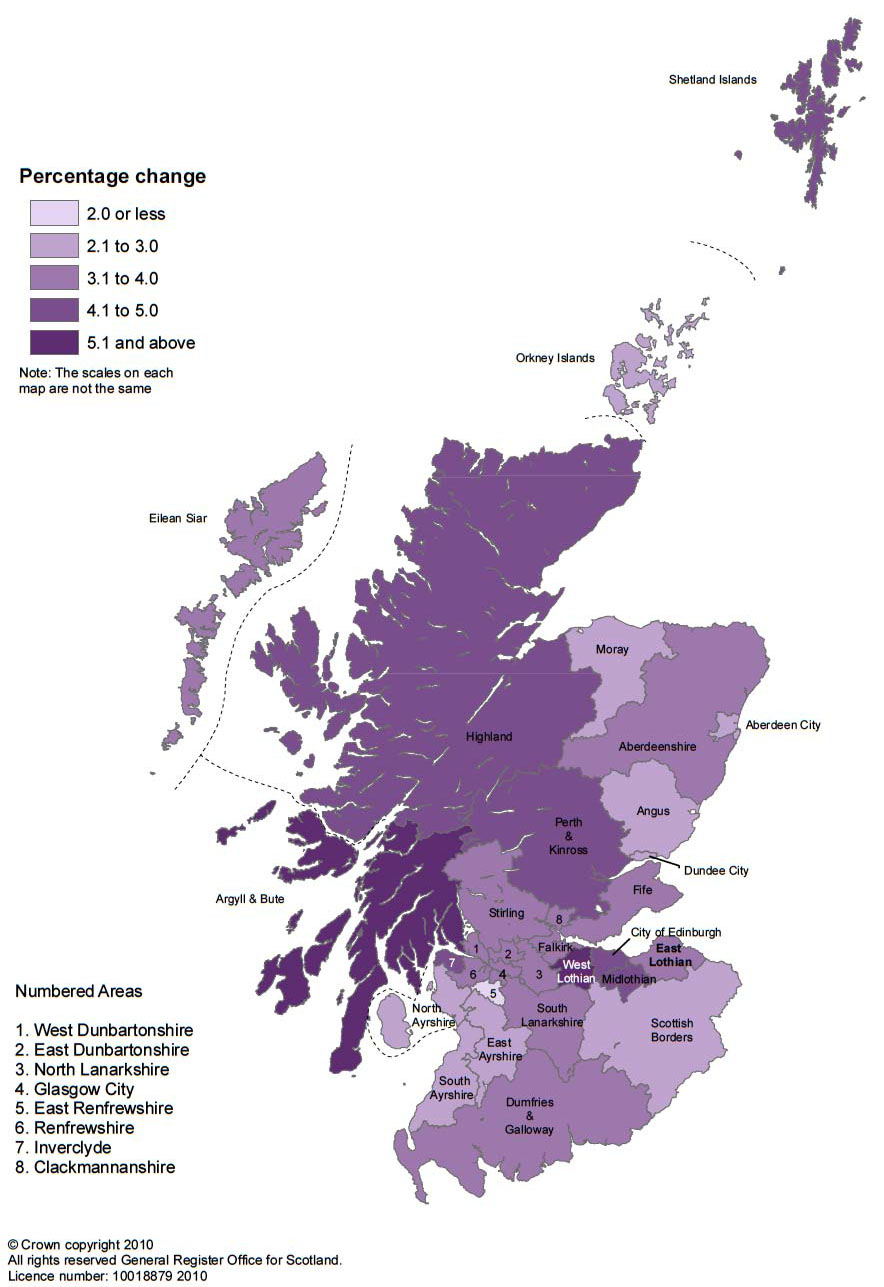
Figure 8 Percentage change in life expectancy at birth between 1997-1999 and 2007-2009, Council areas, Females
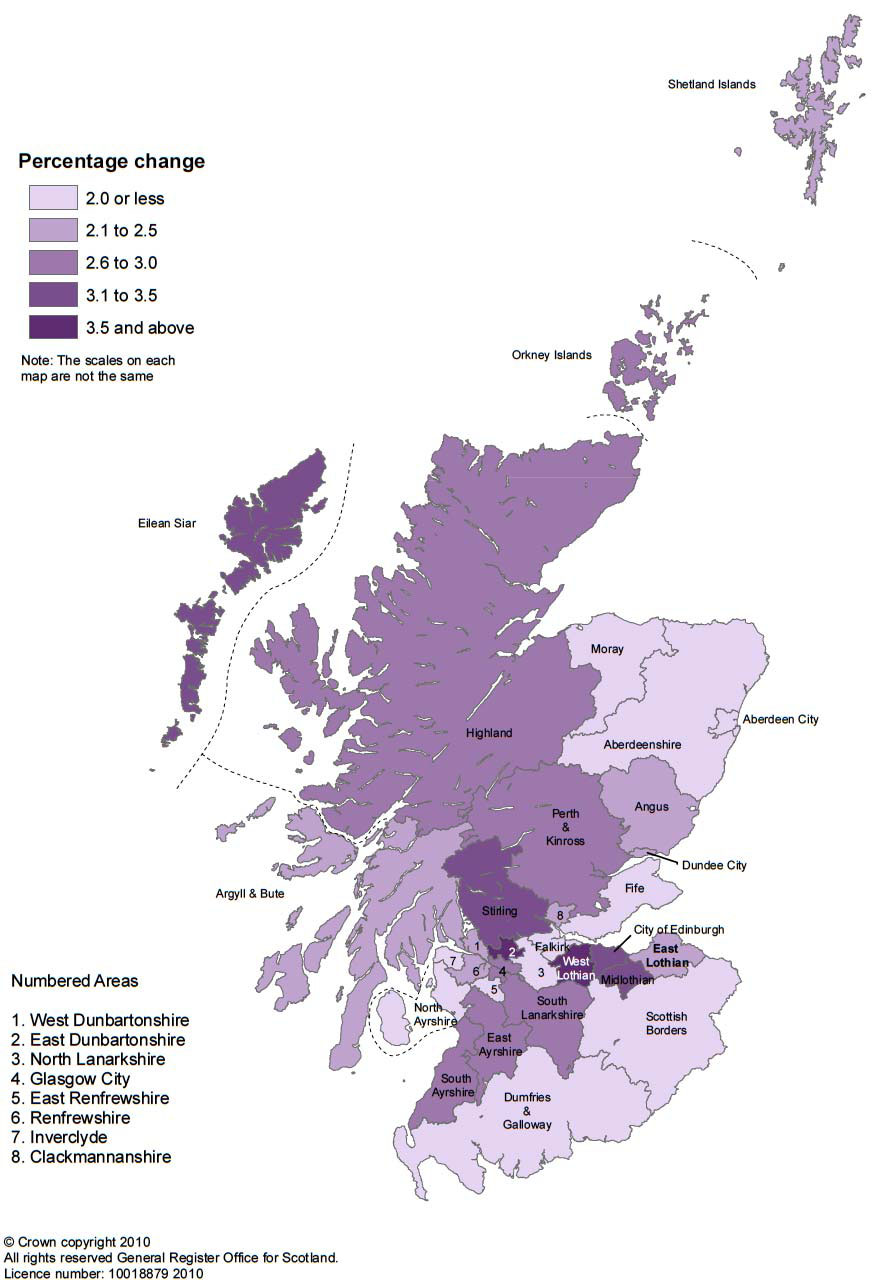
Figure 9a Percentage change in life expectancy at birth between 1997-1999 and 2007-2009, Council areas, Males
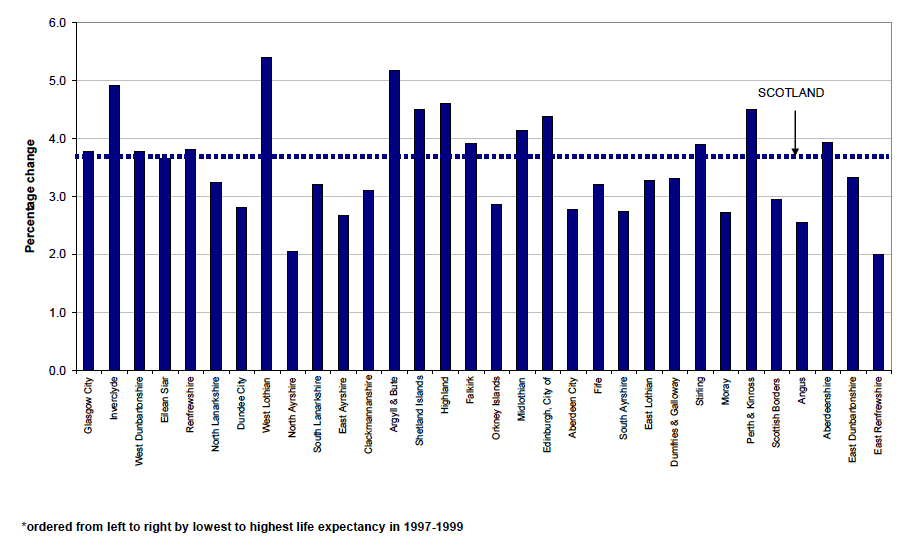
Figure 9b Percentage change in life expectancy at birth between 1997-1999 and 2007-2009, Council areas, Females
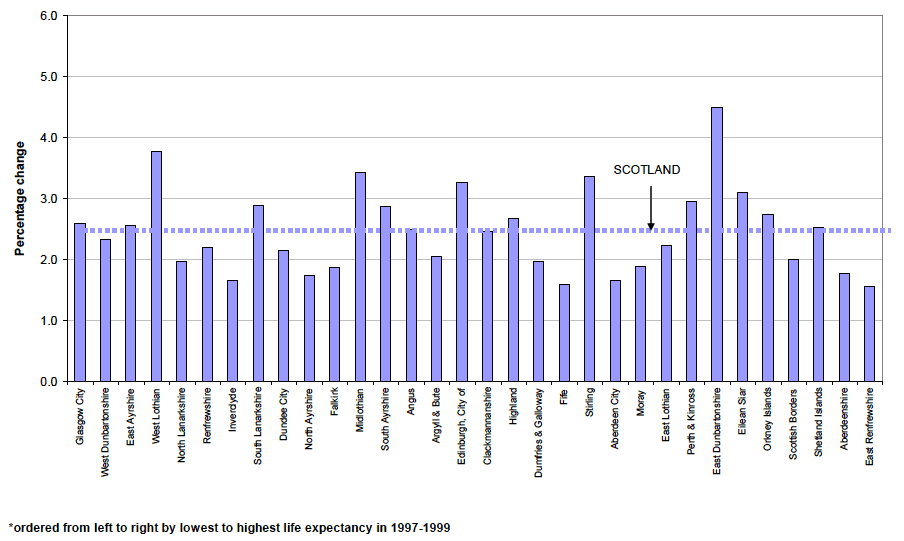
Figure 9c Percentage change in life expectancy at birth between 1997-1999 and 2007-2009, Council areas, Persons
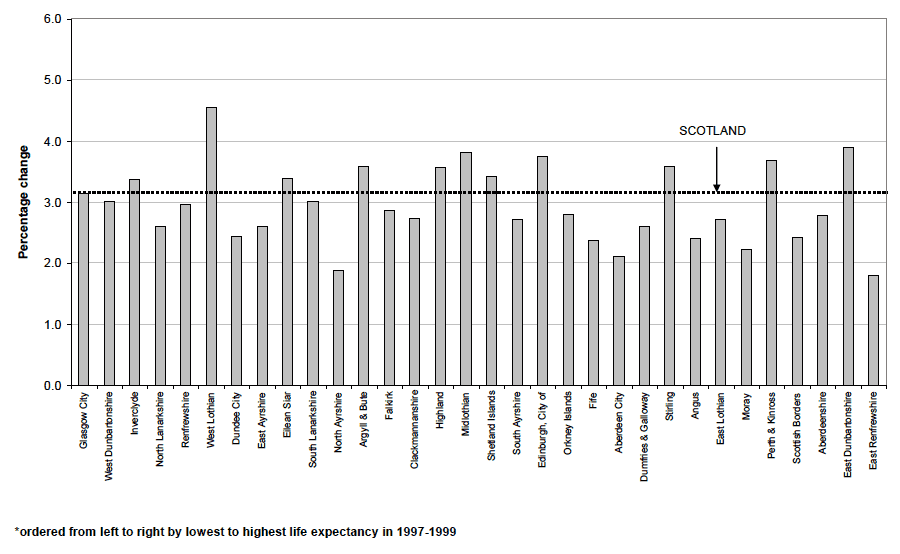
Figure 10 Percentage change in life expectancy at birth between 1997-1999 and 2007-2009, NHS Board areas, Males
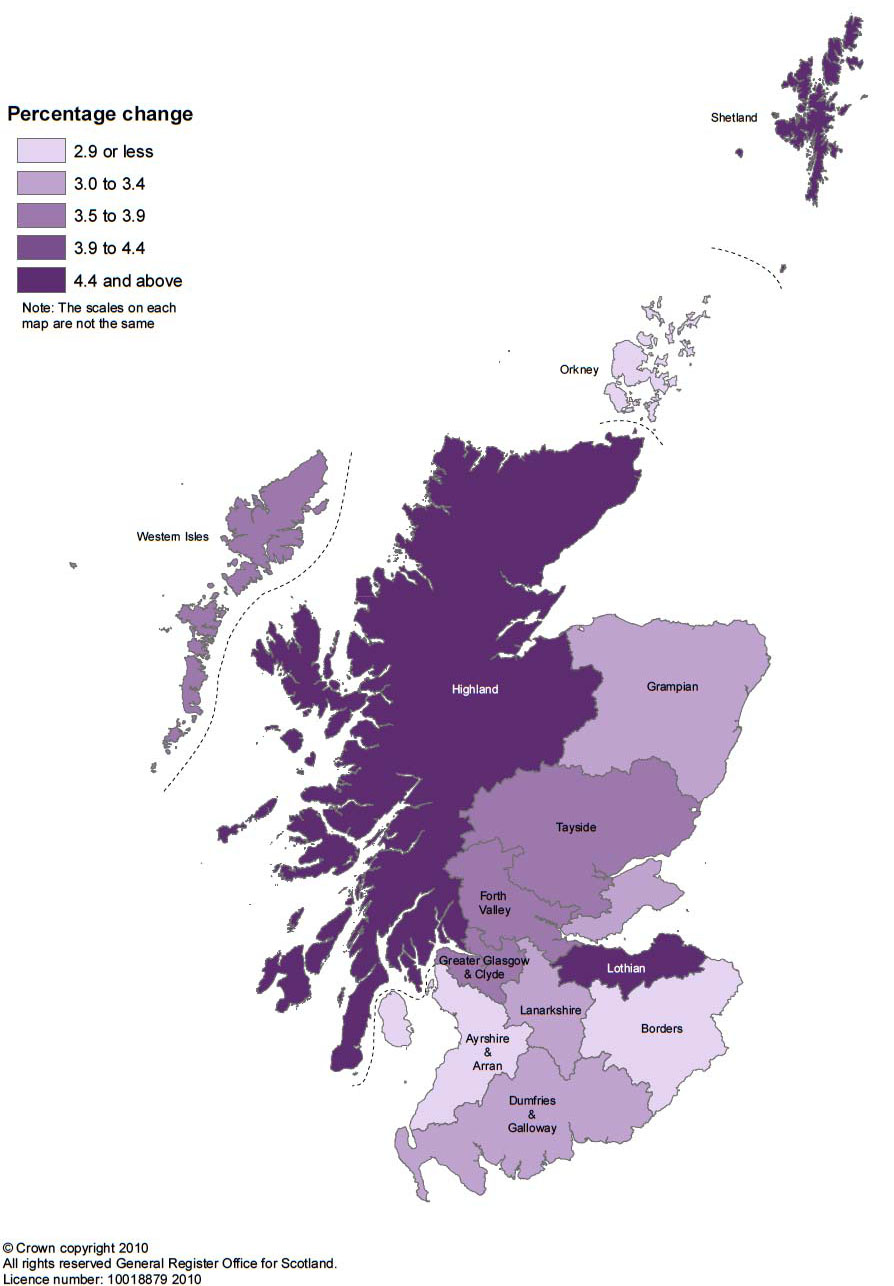
Figure 11 Percentage change in life expectancy at birth between 1997-1999 and 2007-2009, NHS Board areas, Females

Figure 12a Percentage change in life expectancy at birth between 1997-1999 and 2007-2009, NHS Board areas, Males
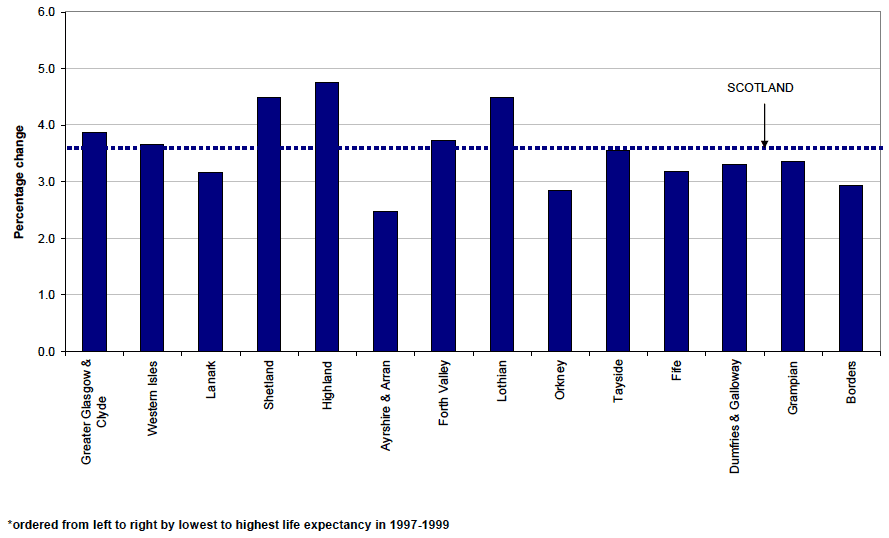
Figure 12b Percentage change in life expectancy at birth between 1997-1999 and 2007-2009, NHS Board areas, Females
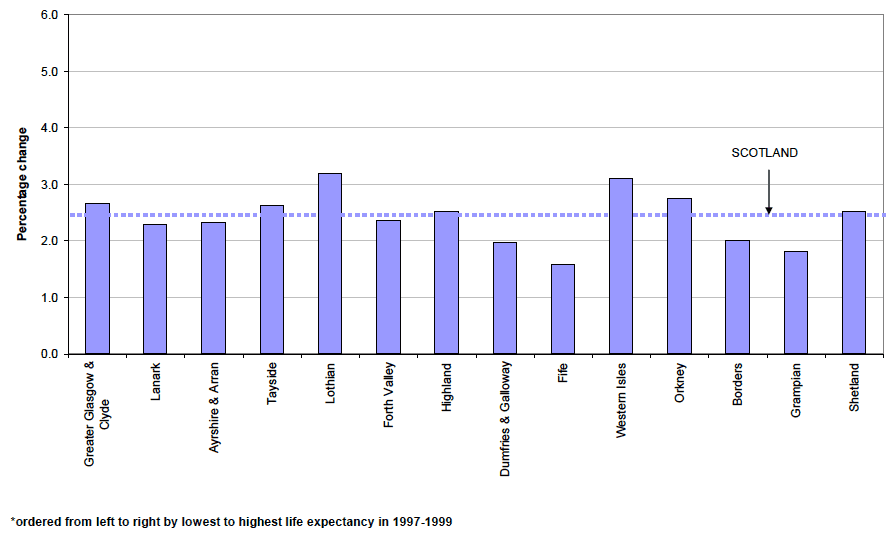
Figure 12c Percentage change in life expectancy at birth between 1997-1999 and 2007-2009, NHS Board areas, Persons
